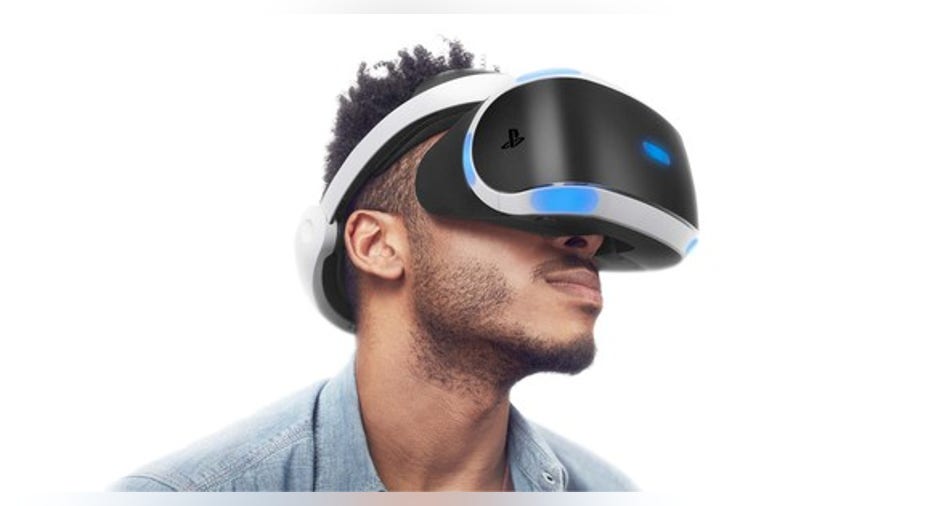3 Top Virtual Reality Stocks

The virtual reality market could grow from nearly nothing in 2015 to$30 billion by 2020, according to tech M&A advisory firm Digi-Capital. Piper Jaffray claims 500 million VR headsets could be sold by 2025.
Those numbers sound impressive, but it might be tough to figure out which companies will benefit the most from that growth. In this article, I'll discuss three tech companies that could generate fresh revenue streams from VR in the near future.
Image source: Oculus VR.
Facebook (NASDAQ: FB), which bought Oculus VR for$2 billion two years ago, is the top VR company to watch because it launched the first high-end commercial VR headset with the Oculus Rift and the first VR app ecosystem with Oculus Home.
Piper Jaffray predicts that the company will sell 3.6 million Oculus Rifts this year, and Facebook claimed in May that there were already 250 apps available inOculus Home, which also servesSamsung's mobile-based Gear VR headsets. Piper estimates that Samsung will sell 5 million Gear VR units this year, mainly because the $99 mobile-based device costs much less than the $600 Rift.
Oculus Home. Image source: Oculus VR.
But Facebook isn't depending on Rift sales for growth. Instead, it's likely selling the devices at near break-even levels to spur sales of digital content through Oculus Home, where it retains a 30% cut of each sale. With Rift and Gear VR owners tethered to that ecosystem, Facebook could generate meaningful app revenue -- something which it couldn't do during the smartphone generation without a dominant mobile OS. Several Oculus Home games can already be played online with other players, which offers us a glimpse into the future of remote visits in VR space.
Oculus Rift and Oculus Home sales won't generate much revenue for Facebook, which generates most of its sales from ads, in the near future. But over the next few years, app revenues could climb, and Facebook could tether its social network into virtual reality, offering users a game-changing way of remotely interacting with their family and friends.
Sony
Sony (NYSE: SNE) will launch the PlayStation VR, a VR headset for the PS4, in October. The headset costs $400, while a bundle including thePlayStation camera and Move controllers will cost $500. Piper predicts that Sony will sell 1.4 million PSVRs this year.
Image source: Sony.
Since the PS4 only costs $400, the PSVR offers a more affordable high-end VR experience than the Rift or HTC's Vive ($800), which both require high-end PCs that cost atleast $600. While the PSVR will work with current PS4s, the upcoming PS4 Neo upgrade couldboost the performance of VR games for a smoother experience. It also differentiates the PS4 from Microsoft'sXbox One, which doesn't have a dedicated VR headset yet.
Strengthening the Game & Networks Services (G&NS) unit is a top priority for Sony, since it's the only business segment that posted double-digit annual sales growth last quarter. All of the other segments, except for Pictures and Music, posted annual declines. Sony could also strengthen those two businesses by selling VR/3D versions of its movies or music videos through the PlayStation Store.
AMD
AMD (NASDAQ: AMD) is the chipmaking underdog that lost market share to Intel's (NASDAQ: INTC) x86 chips and Nvidia's (NASDAQ: NVDA) high-end GPUs over the past decade. But despite those headwinds, AMD is still well-poised to capitalize on the growth of the VR market.
First, AMD's RX 480 was the first $200 graphics card which could be used for VR gaming. PC builds using that card, including the $600 example I just mentioned, knocked the price of "VR ready" PCs under $1,000. Nvidia recently countered the4GB RX 480 with the 3GB GTX 1060 at $200, but AMD already established a first-mover's advantage in the low-end VR space. Robust sales of the RX cards could lift its Computing and Graphics segment, whichposted a 14% year-over-year decline in sales last quarter.
RX 480. Image source: AMD.
Second, AMD's semi-custom APUs power the Xbox One and PS4. That's because APUs pack CPUs and GPUs together in smaller, more power-efficient packages than stand-alone processors. It's a rare strength that Intel and Nvidia -- the respective leaders in high-end CPUs and GPUs -- notably lack.
That strength boosted AMD's EESC (Enterprise, Embedded, and Semi-Custom) revenues by 25% annually last quarter, and upcoming upgrades for the Xbox One and PS4 should ensure that growth continues. If hardware makers start manufacturing stand-alone headsets that aren't tethered to mobile devices or PCs, they could follow the footsteps of consoles and use AMD's APUs -- thus widening its moat against Intel and Nvidia.
The key takeaway
The VR market is still in the early stages of development, and long-term forecasts might not be that accurate. But if you believe that VR headsets could become the next big computing platform after computers and smartphones, Facebook, Sony, and AMD could all profit from that paradigm shift.
A secret billion-dollar stock opportunity The world's biggest tech company forgot to show you something, but a few Wall Street analysts and the Fool didn't miss a beat: There's a small company that's powering their brand-new gadgets and the coming revolution in technology. And we think its stock price has nearly unlimited room to run for early in-the-know investors! To be one of them, just click here.
Leo Sun has no position in any stocks mentioned. The Motley Fool owns shares of and recommends Facebook and Nvidia. The Motley Fool owns shares of Microsoft. The Motley Fool recommends Intel. Try any of our Foolish newsletter services free for 30 days. We Fools may not all hold the same opinions, but we all believe that considering a diverse range of insights makes us better investors. The Motley Fool has a disclosure policy.



















